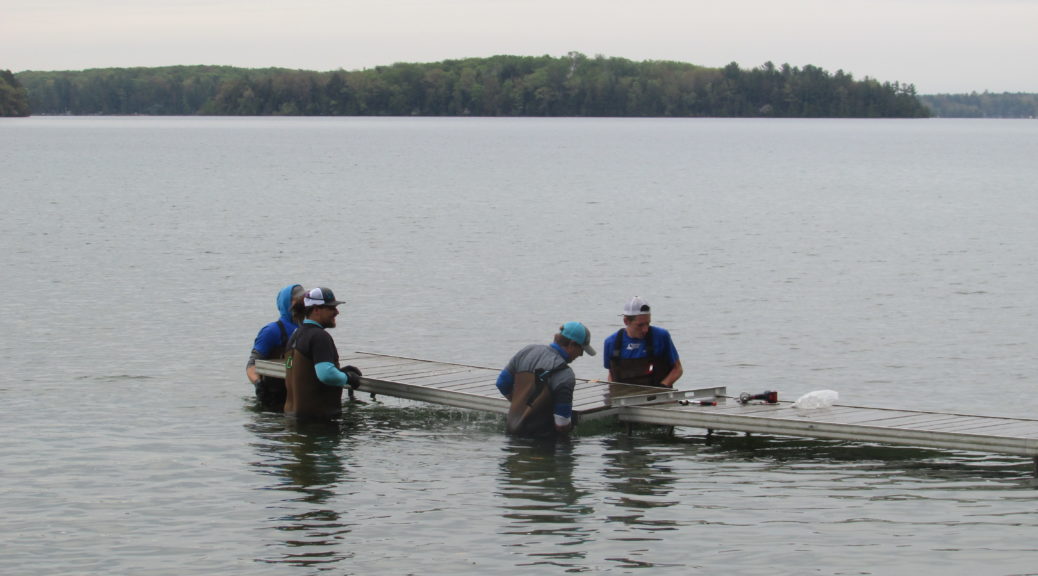by Stewart McFerran, Regular GTJ Contributor
Dockaquacology takes place in the anonymity of the cold Spring water of the lakes of Northern Michigan. The dockaquacologist drives the sections from stacks on the shore into place with waders on. The sections are manufactured with precision using exotic metals. They fit together and are leveled to within inches of the water’s surface, they run straight and true for hundreds of feet to that magic ski boat depth.

The docks are strong enough to hold the entire family and more. Strong enough to hold up to being beaten with a rock by the dockaquacologist when something gets stuck, but not strong enough to stand up to the crushing force of the Winter ice. That is why teams of dockaqucologists return in the Fall to remove sections and float the hosts. Everything is stacked back onto prime waterfront.
Docks and piers in Northern Michigan were once the center of commerce. Many ships tied up and were loaded and unload at these structures. The pilings that held these piers have been ground to nubs by the ice. Those nubs can still be seen at ghost town locations near Good Harbor, Otter Creek and Pierport.

Docks are now the center of recreational activities. All manner of shiny craft are loaded with coolers, water skies, dogs and children. Water fronts are readied for the recreational boaters after the ice melts and before Memorial Day. The dockaquacologist imagines all the activities at the dock as he assembles the family fun land. (I am sure there are lady dockaquacologists but I have yet to meet one.)
I recently interviewed Wes Worden and his crew as they installed a dock with three boat hoists on Long Lake. We met at the Crescent Shore boat launch and boarded the “barge” and took a short ride to the site where the dock was to be erected. Long Lake was quiet that morning and the shoreline had a pristine appearance with only a few docks.

The barge was tied up next to the stack of dock sections and the crew of four: Wes and crew put on waders and got ready for the cold Long Lake water. The barge contained all the tools the crew would need. They started by fitting large wheels into the base of the huge boat lifts and rolling them into the shallow water. Then Wes artfully set the first section of dock into the real estate.
Each section was assembled and dropped into the water legs up to be floated into place. Wes used a level to make sure each section was true. Levy rolled the sections in chest deep water and in legs down position the sections were set in place and bolted. The legs were tamped into the sand and gravel of the lake bottom.
Once the dock was complete, large pieces of foam were tucked under the boat hoist. All four men guided this huge machine into chest deep water where the foam was kicked out and the hoist dropped into place right next to the dock.

Imagine the shores in their pristine state without the vast array of equipment water front owners deploy with the help of dockaquacologists. Huge white pine and cedar overhanging the banks provided shade for fish to spawn, fur bearing creatures to hunt and fowl to nest. The shores are the most vital and productive areas for wildlife and the most pleasant for humans. We now dominate the shore for our own pleasure with a wild assortment of gadgets. Together these watercraft leak oil and gas into the water and have numerous other harmful effects on the shallow waters of our lakes. (1)

When I saw Dockaquacologist Gabe take a ride on a large chunk of foam back to shore I was reminded of Bruce Catton’s description of loggers. Note, Wes and crew were a fine group of men. They did not fight and clearly relished the work on the water.
“But hard living and hard fighting were not the whole story. There were easy stretches on every drive – times when the logs floated smoothly down a steady current, with no tangles, no jams and nothing to worry about. At such moments a riverman would jab the spike of his peavey into one end of the log, light his pipe, look up at the clouds, and let all of tomorrow’s problems take care of themselves. This is the time when he saw the glamor of his own existence, and reveled in it.” (2)

The dockaquacologist has occasional easy stretches where the sections bolt together and level without problem. At such moments the dockaquacologist sees the glamor of his own existence and revels in it in a way that those with shiny toys tied up to the dock will not witness.
(1) The Effects of Motorized Watercraft on Aquatic Ecosystems. Timothy R. Asplund, University of Wisconsin
(2) Waiting for the Morning Train. Bruce Catton
Stewart A. McFerran is a former deck hand with Lang fisheries in Leland MI. Leader of the Antioch College Great Lakes Environmental Field Program and Innisfree Naturalist.


One of these days I gotta give up boating with fossil fuels. It’s an addiction that started when I was a kid on Bass Lake north of Greenville. 3 hp McCullough and every day to bass fish by myself. Of course, I have rowed many boats many miles too. This short piece gives me pause. I know I have an imprint on the water I use. I don’t use my motors that often, but have been feeding my love of sailing into quieter pursuits.
Thanks for commenting, Mike! We’re glad to hear the piece gave you some food-for-thought. There’s a lot of wisdom in your observations. Good luck on the water, and stay safe, whichever mode of power you’re using!